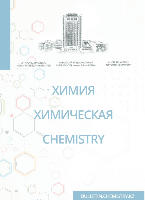
Chemical Bulletin of Kazakh National University
Scope & Guideline
Catalyzing Ideas in the World of Chemistry
Introduction
Aims and Scopes
- Environmental Chemistry:
The journal focuses on the study of chemical processes occurring in the environment, including the analysis and remediation of pollutants such as heavy metals and organic compounds. - Materials Science and Nanotechnology:
It publishes research on the synthesis and characterization of novel materials, including nanocomposites and polymers, which have applications in various fields such as energy, medicine, and environmental science. - Analytical Chemistry:
The journal covers advancements in analytical techniques, particularly in the context of environmental monitoring and the detection of chemical compounds in complex matrices. - Organic and Inorganic Synthesis:
Research involving the synthesis of new organic and inorganic compounds, including their structural and functional properties, is a core focus area. - Polymer Chemistry:
The journal emphasizes the development and characterization of polymeric materials, including their applications in drug delivery systems and environmental remediation.
Trending and Emerging
- Green Chemistry and Sustainability:
There is an increasing focus on sustainable practices in chemistry, including the development of eco-friendly materials and methods for reducing environmental impact. - Advanced Analytical Techniques:
Recent publications highlight a trend towards utilizing sophisticated analytical methods, such as solid-phase microextraction and neutron activation analysis, to enhance detection and analysis capabilities. - Drug Delivery Systems:
Research on innovative drug delivery mechanisms, particularly using polymer systems for targeted therapies, has gained traction, reflecting the intersection of chemistry and biomedical applications. - Photocatalysis and Environmental Remediation:
The exploration of photocatalytic processes for pollutant degradation indicates a rising interest in utilizing chemical processes for environmental cleanup. - Nanotechnology in Energy Applications:
The synthesis and application of nanomaterials for energy storage and conversion, such as magnesium-ion batteries, are emerging as significant areas of focus.
Declining or Waning
- Traditional Chemical Synthesis:
Research focused solely on classical synthesis methods with minimal innovation has decreased, as the journal shifts towards more advanced and interdisciplinary approaches. - Heavy Metal Analysis in Agriculture:
There has been a noticeable decline in studies specifically analyzing heavy metals in agricultural settings, possibly due to a shift towards broader environmental studies. - Basic Physical Chemistry:
Papers centered on fundamental physical chemistry concepts have become less frequent as the journal emphasizes applied research and practical applications in technology and industry.
Similar Journals

Chemical Methodologies
Pioneering the Future of Chemical ScienceWelcome to Chemical Methodologies, a premier journal published by SAMI PUBLISHING CO-SPC, dedicated to advancing the field of chemistry through innovative research and methodologies. With an ISSN of 2645-7776 and an E-ISSN of 2588-4344, this journal provides a vital platform for researchers and scholars to share their findings in areas encompassing physical, theoretical, and organic chemistry. Despite its initial HIndex and quartile rankings still being established, the journal's evolving impact within the academic landscape is underscored by its Scopus Ranks, which place it in the 35th percentile for physical and theoretical chemistry and the 33rd percentile for organic chemistry. Since its inception in 2022, and continuing through 2024, Chemical Methodologies aims to foster collaboration and knowledge dissemination among academics and practitioners alike, bridging theoretical concepts and practical applications. This open-access platform enhances accessibility for researchers and students worldwide, ensuring that groundbreaking contributions to chemical science reach a broad audience.
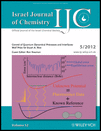
ISRAEL JOURNAL OF CHEMISTRY
Your Gateway to High-Quality Chemistry ResearchIsrael Journal of Chemistry is a leading international journal published by Wiley-VCH Verlag GmbH, dedicated to advancing the field of chemistry through high-quality research publications. With an impressive Q1 ranking in the Chemistry (Miscellaneous) category of the 2023 Scopus rankings and a solid percentile standing of 73rd, this journal plays a vital role in disseminating significant findings to a global audience. Established in 1963, it has maintained a legacy of excellence in chemistry until 2024, covering a wide range of topics including organic, inorganic, physical, and analytical chemistry. While not offering open access, the journal remains a crucial resource for researchers, professionals, and students seeking to enhance their knowledge and contribute to the field. With its rigorous peer-review process and commitment to scientific integrity, the Israel Journal of Chemistry continues to be a beacon of innovation and scholarship in the ever-evolving landscape of chemical research.

JOURNAL OF THE INDIAN CHEMICAL SOCIETY
Bridging Academia and Industry in the Chemical RealmJournal of the Indian Chemical Society, published by Elsevier, stands as a cornerstone in the field of chemistry, particularly representing the rich chemical research emanating from India.
With a significant history dating back to its establishment, this journal encompasses diverse disciplines including Drug Discovery, Electrochemistry, Inorganic Chemistry, Organic Chemistry, and Physical and Theoretical Chemistry, reflecting the evolving landscape of chemical sciences.
Despite being positioned in the Q3 category across multiple quarters, the journal demonstrates promising rankings in various chemistries, highlighting its commitment to advancing the knowledge and application of chemical sciences. While currently not available as an open access journal, the Journal of the Indian Chemical Society is dedicated to providing a platform for high-quality research that fosters innovation and collaboration among researchers, professionals, and students worldwide.
With its continuous publication from 1973 to the present, it serves as an essential repository for cutting-edge findings and developments in chemistry, striving to connect academia with industry and practice.

RUSSIAN CHEMICAL BULLETIN
Fostering Collaboration in the World of Chemical Science.RUSSIAN CHEMICAL BULLETIN, published by SPRINGER, serves as a pivotal resource in the field of general chemistry, covering a wide array of topics that impact both theoretical and applied chemistry. With an ISSN of 1066-5285 and a presence since 1993, this journal provides a platform for disseminating significant research findings, practical applications, and novel methodologies within the broader chemistry community. While it currently holds a Q3 ranking in the Chemistry (miscellaneous) category and occupies the 230th position out of 408 in the Scopus rankings, its reputation continues to grow, fostering collaboration and innovation among researchers and professionals alike. Although the journal does not offer an open-access model, it is committed to making findings accessible within the academic community, ensuring that valuable insights can inform future research. With an anticipated convergence of studies extending to 2024, the RUSSIAN CHEMICAL BULLETIN remains an essential reference for those dedicated to advancing chemical science.
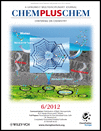
ChemPlusChem
Connecting Researchers to Transform the Landscape of ChemistryChemPlusChem is a premier journal published by WILEY-V C H VERLAG GMBH, dedicated to the vibrant field of chemistry. With an ISSN of 2192-6506 and an impressive Q1 ranking in Scopus's 2023 category for miscellaneous chemistry, this journal serves as a significant platform for the dissemination of high-quality research and innovative findings. Since its inception in 2012, ChemPlusChem has fostered interdisciplinary collaborations, encapsulating a wide array of topics within chemistry that facilitate scientific advancement and education. The journal features a robust open access system, enabling extensive visibility for authors while providing easy-to-access resources for researchers, professionals, and students globally. Located in Weinheim, Germany, ChemPlusChem reflects international standards and ambitions, striving to enrich the global scientific community through rigorous research and engaging scientific discourse.

Ovidius University Annals of Chemistry
Innovative Insights for the Global Chemistry Community.Ovidius University Annals of Chemistry is a prominent open-access journal dedicated to the field of chemistry and chemical engineering, published by OVIDIUS UNIV PRESS since 2012. With its ISSN 1583-2430 and E-ISSN 2286-038X, this journal seeks to foster innovative research and disseminate knowledge across diverse chemical disciplines. Situated in the vibrant academic setting of Ovidius University in Constanta, Romania, this journal receives contributions from a global pool of researchers, enhancing its relevance in the international scientific community. The open-access format ensures that all published articles are freely available, promoting a wider reach and impact of the research dissemination. As a valued resource for academics, industry professionals, and students alike, the Ovidius University Annals of Chemistry plays a crucial role in advancing the understanding of chemical sciences and engineering practices.
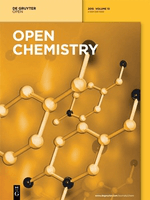
Open Chemistry
Exploring New Horizons in Chemical ResearchOpen Chemistry, published by DE GRUYTER POLAND SP Z O O, is a distinguished peer-reviewed journal that has been serving the global chemistry community since its inception. With an ISSN of 2391-5420 and an E-ISSN also of 2391-5420, this open-access journal has been accessible to researchers and practitioners alike since 2015, ensuring a wide dissemination of high-quality research findings. Located in Germany, specifically at BOGUMILA ZUGA 32A STR, 01-811 WARSAW, MAZOVIA, POLAND, Open Chemistry aims to publish innovative research across various chemical disciplines, with special attention to miscellaneous chemistry and materials chemistry. It is currently ranked in the Q3 category for both fields as of 2023, reflecting its solid standing within the academic community, with specific ranks of 187/408 in General Chemistry and 153/317 in Materials Chemistry, corresponding to respective percentiles of 54 and 51. Open Chemistry not only enhances the accessibility of cutting-edge research but also serves as a vital resource for students, professionals, and scholars seeking to advance their knowledge in the rapidly evolving landscape of chemical sciences.

JOURNAL OF THE CHEMICAL SOCIETY OF PAKISTAN
Fostering Scientific Dialogue in Chemistry.JOURNAL OF THE CHEMICAL SOCIETY OF PAKISTAN is a premier academic journal published by the Chemical Society of Pakistan, focusing on advancing the field of chemistry through rigorous research and scholarship. Established in 1996, this journal aims to disseminate high-quality research articles, reviews, and insights pertaining to various subfields of chemistry, making substantial contributions to both local and international scientific communities. With a current impact factor placing it in the Q4 category, the journal continues to foster discussions on emerging trends and innovations within the discipline. Additionally, it holds a Scopus rank of #305 out of 408, highlighting its growing influence despite being positioned in the 25th percentile. Although it is not an open-access journal, it provides a crucial platform for researchers and professionals in Pakistan and worldwide. The JOURNAL OF THE CHEMICAL SOCIETY OF PAKISTAN serves as a valuable resource for students, educators, and industry professionals alike, facilitating the exchange of knowledge and promoting advancements in chemical sciences.

Canadian Journal of Chemistry
Pioneering Original Research in Chemical StudiesWelcome to the Canadian Journal of Chemistry, a prominent publication dedicated to advancing the study of chemistry through original research and critical reviews. Published by Canadian Science Publishing, this journal has been a cornerstone of chemical research since its inception, covering a broad spectrum of topics within the field, including catalysis, organic chemistry, and general chemistry. With an ISSN of 0008-4042 and E-ISSN of 1480-3291, it provides a vital platform for researchers, professionals, and students to disseminate their findings and engage in scholarly discourse. Impact Factor is currently in development, with the journal classified in the Q4 category for catalysis and Q3 for miscellaneous chemistry fields, signifying its evolving contributions to the scientific community. The journal operates without an open access model, which ensures a rigorous peer-review process while maintaining subscription access for institutions and libraries. Located in Ottawa, Canada, the Canadian Journal of Chemistry continues to provide an invaluable resource for those dedicated to the scientific pursuit of chemistry, making significant strides in fostering interdisciplinary approaches and innovative research methodologies.
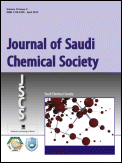
Journal of Saudi Chemical Society
Leading the Charge in Cutting-edge Chemical Discoveries.The Journal of Saudi Chemical Society, published by ELSEVIER, stands as a premier platform for advancing knowledge in the field of chemistry. Since its inception in 2009, this Open Access journal has garnered significant attention, securing a prestigious Q1 ranking in the Chemistry (miscellaneous) category for 2023, reflecting its position among the top journals in the discipline. With an impressive Scopus ranking of #66 out of 408 in General Chemistry, this journal boasts a commendable 83rd percentile, underscoring its impact and relevance in the global research community. The journal aims to disseminate high-quality research articles, reviews, and case studies, fostering innovation and collaboration among chemists and allied professionals. By enabling widespread access to cutting-edge research, the Journal of Saudi Chemical Society plays a crucial role in supporting the educational and professional development of students, researchers, and practitioners alike, making it an essential resource for anyone invested in the dynamic field of chemistry.